

WWE. WWE. WWE. WWE. Jiu jitsu. UFC. MMA - Wrestling. MMA. MMA. UFC. Free UFC vid. Parkour. Techniques. Assassins Creed. Assassin's Creed Series. Self defense. Krav Maga Pressure Points - Military Hand to Hand Combat Guide. Vale tudo. Vale tudo (IPA: [ˈvali ˈtudu]; English: anything goes) are full-contact unarmed combat events, with a limited number of rules, that became popular in Brazil during the 20th century.[1] Vale Tudo has been considered a combat sport by some observers.[2] Vale Tudo uses techniques from many martial art styles, making it similar to modern mixed martial arts. History[edit] 1920s to 1980s[edit] Fighting sideshows termed "Vale Tudo" became popular in Brazilian circuses during the 1920s.[3] Examples of such bouts were described in the Japanese-American Courier on October 4, 1928:[4] One report from São Paulo declares that Jiu Jitsu is truly an art and that in an interesting exhibition in the side tent to the big circus a Bahian of monstrous dimensions met his waterloo at the hands of a diminutive Japanese wrestler.
Martial arts. The martial art of boxing was practiced in the ancient Thera.
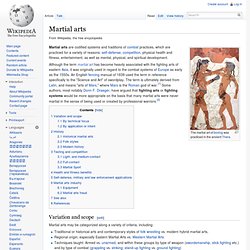
Martial arts are codified systems and traditions of combat practices, which are practiced for a variety of reasons: self-defense, competition, physical health and fitness, entertainment, as well as mental, physical, and spiritual development. Martial arts pressure points. List of martial arts. There are a large number of distinct styles and schools of martial arts.

Sometimes, schools or styles are introduced by individual teachers or masters, or as a brand name by a specific gym. Martial arts can be grouped by type or focus, or alternatively by regional origin. This article focuses on the latter grouping. For hybrid martial arts, as they originated from the late 19th century and especially after 1950, it may be impossible to identify unique or predominant regional origins. ☯ HEALTH ☯
Acupressure. Sleeping tricks. Baby points. Pressure points. Wrestling. Throwing. Martial arts. Krav Maga. Videos. Mental health. Mental Health Resources. Mental Health. Health. Health/Medicine. Medical anatomy tools. Health & Benefit. TV. Martial Arts. Karate. Karate (空手?)
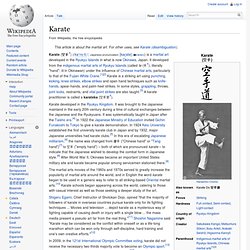
(/kəˈrɑːtiː/; Japanese pronunciation: [kaɽate] ( Karate developed in the Ryukyu Kingdom. It was brought to the Japanese mainland in the early 20th century during a time of cultural exchanges between the Japanese and the Ryukyuans. It was systematically taught in Japan after the Taisho era.[4] In 1922 the Japanese Ministry of Education invited Gichin Funakoshi to Tokyo to give a karate demonstration. Taekwondo. Taekwondo /ˌtaɪˌkwɒnˈdoʊ/ or /ˌteɪˌkwɒnˈdoʊ/ (Korean 태권도 (hangul) / 跆拳道 (hanja), [tʰɛk͈wʌndo]) is a Korean martial art.
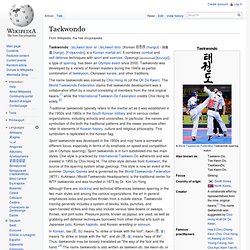
It combines combat and self-defense techniques with sport and exercise. Gyeorugi (pronounced [kjʌɾuɡi]), a type of sparring, has been an Olympic event since 2000. Taekwondo was developed by a variety of Korean masters during the 1940s as partial combination of taekkyeon, Okinawan karate, and other traditions. The name taekwondo was coined by Choi Hong Hi (of the Oh Do Kwan).
The World Taekwondo Federation claims that taekwondo development was a collaborative effort by a council consisting of members from the nine original kwans,[1] while the International Taekwon-Do Federation credits Choi Hong Hi solely.[2] Traditional taekwondo typically refers to the martial art as it was established in the 1950s and 1960s in the South Korean military and in various civilian organizations, including schools and universities. Judo. History and philosophy[edit] Early life of the founder[edit] The early history of judo is inseparable from its founder, Japanese polymath and educator Jigoro Kano (嘉納 治五郎, Kanō Jigorō?
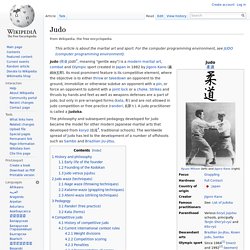
, 1860–1938), born Shinnosuke Kano (嘉納 新之助, Kanō Shinnosuke?). Kano was born into a relatively affluent family. His father, Jirosaku, was the second son of the head priest of the Shinto Hiyoshi shrine in Shiga Prefecture. Jigoro Kano had an academic upbringing and, from the age of seven, he studied English, Japanese calligraphy (書道, shodō?) Early attempts to find a jujutsu teacher who was willing to take him on met with little success. In 1877, as a student at the Tokyo-Kaisei school (soon to become part of the newly founded Tokyo Imperial University), Kano learned that many jujutsu teachers had been forced to pursue alternative careers, frequently opening Seikotsu-in (整骨院?
Jujutsu. Jujutsu (/dʒuːˈdʒuːtsuː/; Japanese: 柔術, jūjutsu listen , Japanese pronunciation: [ˈdʑɯɯ.dʑɯ.tsɯ]) is a Japanese martial art and a method of close combat for defeating an armed and armored opponent in which one uses no weapon or only a short weapon.[1][2] The word jujutsu can be spelled as ju-jitsu/jujitsu, ju-jutsu.
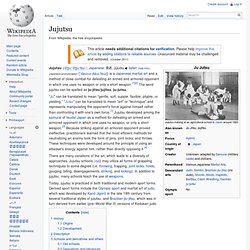
"Jū" can be translated to mean "gentle, soft, supple, flexible, pliable, or yielding. " "Jutsu" can be translated to mean "art" or "technique" and represents manipulating the opponent's force against himself rather than confronting it with one's own force.[1] Jujutsu developed among the samurai of feudal Japan as a method for defeating an armed and armored opponent in which one uses no weapon, or only a short weapon.[3] Because striking against an armored opponent proved ineffective, practitioners learned that the most efficient methods for neutralizing an enemy took the form of pins, joint locks, and throws. Boxing/Kickboxing.
Self Defense Training Academy - Richardson / Dallas/ Plano/ Frisco / Addison, TX. Capoeira. As with its early history, the origins of the word capoeira remains controversial.

There is evidence to suggest that the word originates in Angola, where the word "kapwera" is the Bantu verb meaning "to fight".[7] The word capoeira may have come from the Tupi language, referring to the areas of low vegetation in the Brazilian interior where the game was played (ka'a ("jungle") e pûer ("it was"). It was practiced by slaves and disguised as a dance in order to prevent its capoeiristas from punishment or execution for learning how to fight and defend themselves, which was forbidden to those who were legally defined as property. It is nearly always practiced to traditional Brazilian berimbau music. History[edit] Early history of capoeira is still controversial, especially the period between the 16th century and the early 19th century, because historical documents were very scarce in Brazil at that time.
Aikido. Martial arts.